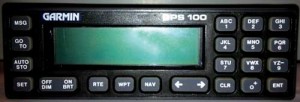by Michael Kaufman
After concentrating my column for the last four issues on autopilots, my efforts will now turn to Global Positioning System, better known as “GPS.”
When asked what the invention of the decade was, many people say, the cell phone. For me the answer would be, “GPS.” I remember trying to navigate around the streets of a strange city using a map and being lost most of the time. Though I can brag that the cases of being lost in airplanes were quite rare, it did happen to me a few times in my early days of flying in the 1960s.

I remember seeing my first GPS at EAA AirVenture Oshkosh in 1991. A new start-up company that no one had heard of called “Garmin” displayed a GPS unit. The reason I remembered the year was that in 1992, I purchased my first GPS for my Bonanza and then used it for delivering a Super Cub to Alaska. In February of that year, I was part of a group of 7 airplanes flying from Florida to the Dominican Republic and my Loran quit working due to P static created by numerous thunderstorms in the area. One of the Bonanzas in that group had a GPS and everyone followed him in loose formation; after all, this was the famous Bermuda Triangle. I still have that first GPS, a Garmin 100, and it still works, although it sits on the shelf in my office.
One more comment before changing the column format to what GPS means today.
When I got my first GPS, all of the satellites were not yet in orbit, so we needed to use a computer program to establish if we would have any coverage in a specific area at a given time or if it would be two-dimensional coverage.
Many of us have been following the proceedings in our capitol about a company called “Light Squared” that had been petitioning the government for the right to build a ground-based cell phone network on the frequency band adjacent to the GPS band. I have been following the proceedings quite closely being a radio geek and amateur radio operator, as well as a concerned pilot. After several rounds of hearings before Congress, things are looking a lot better for pilots and GPS users. On Feb 16, the FCC revoked the waiver of Light Squared that would have allowed them to build a ground-based wireless broadband network adjacent to the spectrum used by GPS. This is a sigh of relief to GPS users, especially pilots who have as much as $10,000 or more invested in a single GPS unit in their aircraft and may have found that unit plagued with interference from this proposed network.
On the technical side of GPS, we need to mention how GPS works.
There are 24 satellites plus several spares that are in low-polar orbits. These satellites transmit their position and a time reference that is picked up by the GPS receivers that do fancy math and theory. By using multiple satellites, you can determine your position. The system is quite accurate, but some errors occurred, so this is why we have added WAAS (Wide Area Augmentation System) to our aircraft GPS receiver. An earlier version of pre-WAAS was called differential GPS, which used ground-based radio transmissions to correct these errors. They were situated mostly along the coastline of the U.S. for marine navigation, and they never became too popular in the aviation community. Today, there are WAAS receivers and sensors located in conjunction with other ground-based navigation systems at airports, which measure the position accuracy of the GPS satellites at a given time. These corrections are then sent first by landline and then via an uplink to several satellites that are in a geostationary orbit over the equator. These corrections are then beamed back to the GPS receiver on a different frequency, and the corrections are made in the GPS receiver. The correction sensors are strategically located at many airports throughout the country, and each of them covers a specific area as the corrections needed in California may be different than the ones for Wisconsin on any given date or time.
There are so many models of GPS units operating in the aircraft we fly, from handheld units to permanently mounted units with moving map functions and enormous databases. They are interfaced to sophisticated autopilots and flight management systems. There are new GPS units that have just hit the market from Garmin and Avidyne, and some new units from several companies will be introduced later this year. I will try to mention all of the popular GPS units and give some of their details and features; however, this will take several issues of Midwest Flyer Magazine to finish, so please bear with me.
There are so many things to consider when purchasing a new GPS, and I may appear as the devil’s advocate on some and partial to others. These are my thoughts and you may disagree, which of course you are all entitled to do. I will concentrate on the world’s most popular GPS in this issue. If you haven’t guessed which GPS this is, the answer would be the Garmin 430/530 units.
When the Garmin 430/530 series first appeared in advertisements in aviation publications, I was impressed and inquired at my local avionics shop as to what the price would be. I was told about 10K, installed, plus options. My response was “No one will spend that kind of money on a GPS.” I was sure wrong on that one. When I did a survey several years ago, I found that there were over 100,000 Garmin 430/530 units sold worldwide.
To compare the differences between the 430 and 530, there are more differences than just the screen size of the moving map. The 530 has displayed on NAV screen # 1, a compass arc that can be used should the heading indicator fail. There is a direction indicator on the 430 as well, but it is not as intuitive as the one on the 530 for emergency backup use. The 530 has a DME function that is tied into the frequency selected on the VOR nav. I call this a DME function, because it is not a true DME and will work even if the ground facility has the DME transmitter out of service. It also does not display slant range to the ground facility as a true DME would. Instead the GPS function will register 0 miles when flying 6076 feet (1 nautical mile) over the VOR. Another plus feature of the 530 is that it will also listen to the NAV frequency and read the Morse code identifier and visually display it to the pilot.
I am very insistent as an instructor that every pilot identifies a ground-based NAVAID before using it. If a NAVAID cannot be properly identified, it could be unreliable for navigation, out of service, or we as pilots could have misread a frequency like I did once when there were two closely spaced airports, both having ILS approaches. I am fluent in Morse code, but many pilots are not, so this feature is a very useful tool found on the Garmin 530.
In most Garmin 530 aircraft installations, I find a second GPS/VOR/COM, which is usually a Garmin 430. The two units complement each other very well, and most avionics shops will configure the two units, so they can communicate with each other electronically.
By putting a flight plan into the 530, there is an option that can be set by the pilot to automatically “cross fill” the flight plan to the 430. This way there is a backup of the flight plan should the 530 fail. The avionics shop can also provide a cross fill cable to do the same to a portable unit like the Garmin 396 or 496, so the pilot can have a backup on his portable should there be an electrical system failure and both the 530 and 430 fail.
The 396 or 496 can operate for several hours on their internal batteries, which was extremely helpful the time I lost the alternator in my Bonanza in IMC. Another plus in having this cross fill feature is the capability to see your proposed route and the weather depicted on the same screen.
There is no way to cross fill from the portable GPS units back to the 530 or 430, which is unfortunate. There is also no way to put an alternate flight plan into the portable GPS when it is connected via cable to the panel mounted units, so instruct the radio shop to put a simple switch in the line to break the connection between the two units.
One more hint for pilots flying the interconnected Garmin 530/430 combination, or a combination of two Garmin 430s, is to allow “auto cross fill” from radio one to radio two, but only manual cross fill from radio two to radio one. This will allow you to fly radio one while modifying or putting a different flight plan into radio two. Should you need to divert to another airport or fly to an alternate, you are ready with a couple of button pushes. Just use the manual cross fill option on radio two and the data will be identical in both units.
Because there are so many aircraft out there flying with Garmin 530/430s, I will concentrate on more tips on these units in the next issue of Midwest Flyer Magazine.
A “superior” pilot is one who uses his/her superior knowledge to avoid situations, which may require his/her superior skills (Author Unknown).
Blue skies on your next flight!
EDITOR’S NOTE: Michael “Mick” Kaufman is the manager for the Beechcraft Pilot Proficiency Program and a flight instructor operating out of Lone Rock (LNR) and Eagle River (EGV), Wisconsin. Kaufman was named “FAA’s Safety Team Representative of the Year for Wisconsin” in 2008. Email questions to captmick@me.com.
